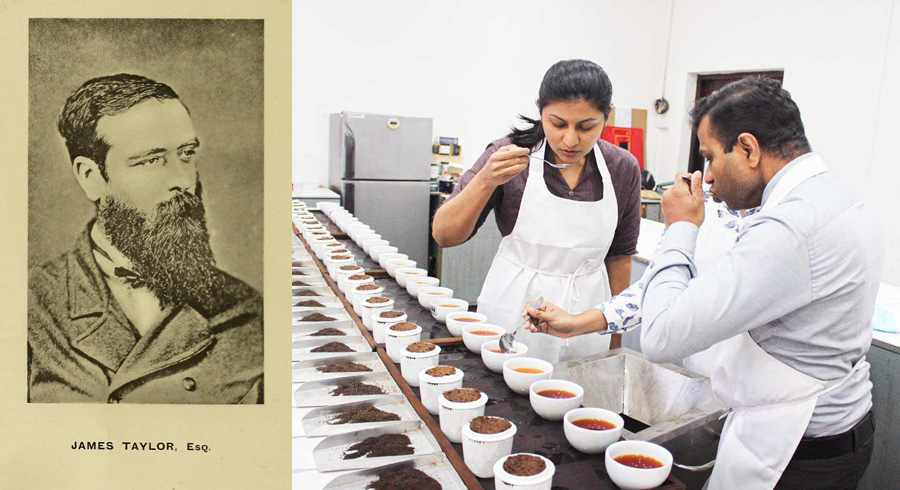The day aims to raise awareness of tea’s long history and its deep cultural and economic significance worldwide, promoting collective action for sustainable production and consumption while highlighting tea’s fundamental role in uplifting the Sri Lankan economy.
The origins of tea stretch as far back 4762 years to Emperor Shen Nong.
Since then, this beverage has been lauded for its flavor, and its contributions to health, culture and socioeconomic development, a legacy which remains as relevant as ever.
Today, tea is grown in many diverse regions across the world, supporting over 13 million livelihoods —including smallholder farmers and their households globally.
Yet of the world’s tea growing regions, none is more unique than Sri Lanka and its famed Pure Ceylon Tea.
Synonymous with premium quality, authenticity, sustainable and ethical production, the island’s orthodox black tea has stood out for nearly 160 years as the world’s most sought after brew.
An unlikely global sensation: the ascendency of Pure Ceylon Tea
Sri Lanka’s own journey towards mastery of tea was non-linear.
In the mid-19th century, Sri Lanka’s plantation economy teetered on the brink of collapse.
Coffee had been the island’s main export, but when a virulent strain of coffee-rust fungus struck in 1869, entire estates were laid waste.
Facing financial ruin, enterprising planters turned their gaze toward tea—a crop that, until then, had been little more than an experimental curiosity.
Among those visionaries was James Taylor, a young Scottish planter who in 1867 began cultivating tea on a seven-hectare plot at Loolecondera Estate near Kandy.
Taylor’s rigorous trials, conducted with Assam hybrid seedlings from the Peradeniya Botanical Gardens, quickly demonstrated tea’s promise.
By 1872, he had erected a rudimentary factory of his own design, complete with a leaf-cutting machine, and sent the first small consignment of Ceylon tea to London.
Overcoming initial skepticism, early tasting reports praised its bright liquor and brisk flavour—qualities that would soon distinguish Ceylon tea on the global stage.
The rest as they say is history.
What began as a lifeline for a struggling coffee sector rapidly evolved into a powerful engine of growth in its own right.
Within a decade, hundreds of acres of abandoned coffee fields had been replanted with tea, and the landscape of the central highlands was transformed.
Railway lines, initially built for coffee, were extended deeper into the hills to carry the new tea harvests, while Colombo agency houses organized exports to European markets.
By the 1888s, Ceylon tea was commanding premium prices.
While the cultivated extent of tea exceeded peak coffee cultivation, it’s emergence not only salvaged the island’s plantation economy but laid the foundation for what would become the world’s sole benchmark for a quality cuppa.
An island of diversity: the recipe for global success
Found across the island’s picturesque central mountains and down to its southern foothills, Sri Lanka tea’s shifting elevations, winding valleys and patchwork microclimates combine to shape distinct qualities in every harvest that cannot be found anywhere else in the world.
Sri Lanka’s tea country unfolds across three elevation bands, each imparting its own signature.
High-grown gardens above 1,200 meters—like the fog-shrouded slopes of Nuwara Eliya and the undulating heights of Dimbula—thrive in cool, misty air that slows leaf growth and concentrates delicate floral aromas.
Their cups are bright and fragrant, with Nuwara Eliya often likened to champagne, while Dimbula brings a mellow sweetness and fine golden hue.
Mid-grown estates between 600 and 1,200 meters—anchored by Uva, Uda Pussellawa and Kandy—experience moderate temperatures and alternating monsoon rains that sculpt versatile flavours.
Uva teas carry an aromatic natural bouquet.
The famous desiccating ‘kachan’ winds that originate in the arid deserts of North India and sweep across Sri Lanka’s Eastern slopes and through the Malwatte belt between July and September each year, these seasonal valley-grown teas are among Sri Lanka’s most prized produce.
Uda Pussellawa yields darker, tangy infusions with liquors of medium body and a rosy character; and Kandy, one of the island’s oldest regions, delivers a sturdy copper brew with spicy, nutty depth.
Below 600 meters, low-grown districts such as Ruhuna and Sabaragamuwa bask in warmth and humidity.
Here the long sunshine hours and gentle breezes of the southern plains accelerate leaf growth, producing full-bodied teas with dark liquor—robust and richly flavoured in Ruhuna, softly sweet with caramel hints in sprawling Sabaragamuwa.
An evolving range of premium varietals
Even within a single estate, ridges, hollows and varying exposures create micro-climates that lend subtle nuance to each.
It is this intricate interplay of elevation, soil, wind and rain that gives Pure Ceylon Tea its extraordinary diversity and a character which cannot be found anywhere else in the world.
These qualities are further characterized by two dominant distinct wet and dry monsoons; the North East and the South West.
The North East monsoon from October to January and the South West monsoon from May to August.
Upholding centuries-old orthodox methods, the majority of Sri Lankan tea bushes are still hand-plucked with “two leaves and a bud” at first light and processed through careful withering, rolling and oxidation to preserve leaf integrity and maximise flavour.
In recent decades, Ceylon’s high-elevation estates have also produced exceptional green and white teas.
Sun-withered “Silver Tips” and lightly steamed green leaves showcase delicate floral and grassy notes, commanding premium prices and demonstrating that Sri Lanka’s mastery extends far beyond its black tea heritage.
Innovators have also revived heirloom cultivars like “Golden Curls” and introduced single-estate seasonal flushes, each offering a distinct taste of its garden’s terroir.
People & Communities—Stewards of the Leaf
Behind every cup of Pure Ceylon Tea lies the labour and dedication of estate workers and smallholder farmers.
While livelihoods in the tea sector have always been a contentious issue, Sri Lanka tea harvesters have continuously earned as much as 50% more than their peers in comparable tea-producing countries.
Smallholders, who now account for almost three-quarters of national production, cultivate tea on family plots that supply a network of tea factories – both independent and connected to Regional Plantation Companies (RPCs).
Many of these factories are now global leaders in adoption of rooftop solar, biomass, mini-hydro and other energy efficient mechanisms that are reshaping efficiency in the global plantation industry.
The Planters’ Association of Ceylon has long championed these stewards of the leaf, pioneering training programmes in sustainable agronomy and ethical workplace standards.
Through RPC-led certification schemes, global best practices in modernized and precision agriculture have been integrated into daily operations, including integrated pest management, water, soil, flora and fauna conservation techniques that protect both the environment and tea quality.
Crucially, significant portions of revenue generated from tea flows back into rural schools, clinics and infrastructure projects, reinforcing tea’s role as an engine of social development.
RPC estates also fund Child Development Centers which provide early childhood education and nutrition.
These initiatives which have resulted in significant improvements in health and overall education outcomes among the 1 million strong community that resides on the estates, as well as the approximately 125,000 strong RPC workforce and their families.
Women’s empowerment initiatives including focused opportunities for professional development and career advancement have opened new avenues in Sri Lanka’s tea industry to rise into positions that under colonial rule were closed off to them.
Community centres double as agricultural extension hubs, blending technical advice with literacy classes and health screenings.
These efforts underscore a central truth: the strength of Pure Ceylon Tea rests not only in its soil and climate but in the hands of the people who cultivate it.
As global demand grows, it is this human network of skilled pickers, innovative smallholders and community advocates working in partnership with globally respected RPCs that set standards and continue to drive innovation that ensures Ceylon tea remains a model of quality, sustainability and shared prosperity.
As the industry evolves to cater to traditional demand as well growing value-added innovations including tea concentrates, essences, and ready-to-drink formats —it remains rooted in the hands of dedicated estate workers and smallholder families who uphold standards of quality and sustainability.






















